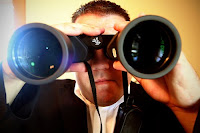Have been slogging my way reading the first few books of the Bible's Old Testament. These were people 'on the move' and used to regular change. Found some interesting insights to share with you from one particular point in their history...
Israel for most of its history was a collection of nomadic tribes. Change happened constantly when you were moving and taking up new territory. Here are some lessons their leader Moses gave before they were to take over lands and cities on their march to possessing the territory their God had promised to them:
1. When you go to war (face a new change), and see that it is far bigger than your capacity, don’t be afraid.
In Israel’s case they could believe that because their God said He was going ahead of them and preparing the way. I recognize God may not be part of your thinking & planning. If God isn’t a part of your plans, then what is the confidence you are taking with you that this change is going to work? You have to start with confidence. No confidence, no guts in the face of the challenges change will throw at you. No guts, no glory.
2. If you are not fully prepared to engage the change and all it entails, then don’t.
Army captains were to say to their warriors that if any of them had commitments to take care of first (like: they just got married or were still building a house), then they were to go take care of those commitments first before entering the fight. What might you as the leader need to take care of first in order to fully engage the change you are entering? This advice also suggests that leaders need to identify the ones who are ready to move forward, and leave others to continue to complete their current commitments. Some should not go with you – it’s just not the right time for them. In fact, some should be left behind to develop and be ready for a later phase of the change.
3. Finally, in the pursuit of new territory, don’t destroy what’s needed to feed you in the long run.
Moses’ advice to warriors when they were besieging a city was to not cut down every tree in the area in order to build the ramparts. “Leave the fruit trees” he said, "otherwise what’s going to feed you when you’ve captured the city and settle down?" How often have you seen a person tear down the past in pursuit of the future, or belittle the existing structure/organization as a justification for breaking new ground? They leave the ground barren, empty of 'trees', devoid of currently existing resources that could have helped them make their new future into reality.
In pursuit of the new, sometimes we still need the old to feed us, support us and sometimes even finance us!
It’s easy to view the organization or situation we are currently in (and want to change) as a hairball that stifles us. We want freedom. Gordon Mackenzie’s book “Orbiting the Giant Hairball” is an insightful & creative look at how to manage the relationship between the “hairball” of our current organizational context, and the creative change that typically can only be born outside of it.
as a hairball that stifles us. We want freedom. Gordon Mackenzie’s book “Orbiting the Giant Hairball” is an insightful & creative look at how to manage the relationship between the “hairball” of our current organizational context, and the creative change that typically can only be born outside of it.
(For those interested in reading the full account of Moses’ advice, refer to the Bible, the book of Deuteronomy, chapter 20)
Wishing you a successful and prosperous 2011
Harv Matchullis - back from Kuwait and settled in Canada. Still ever the nomad...








